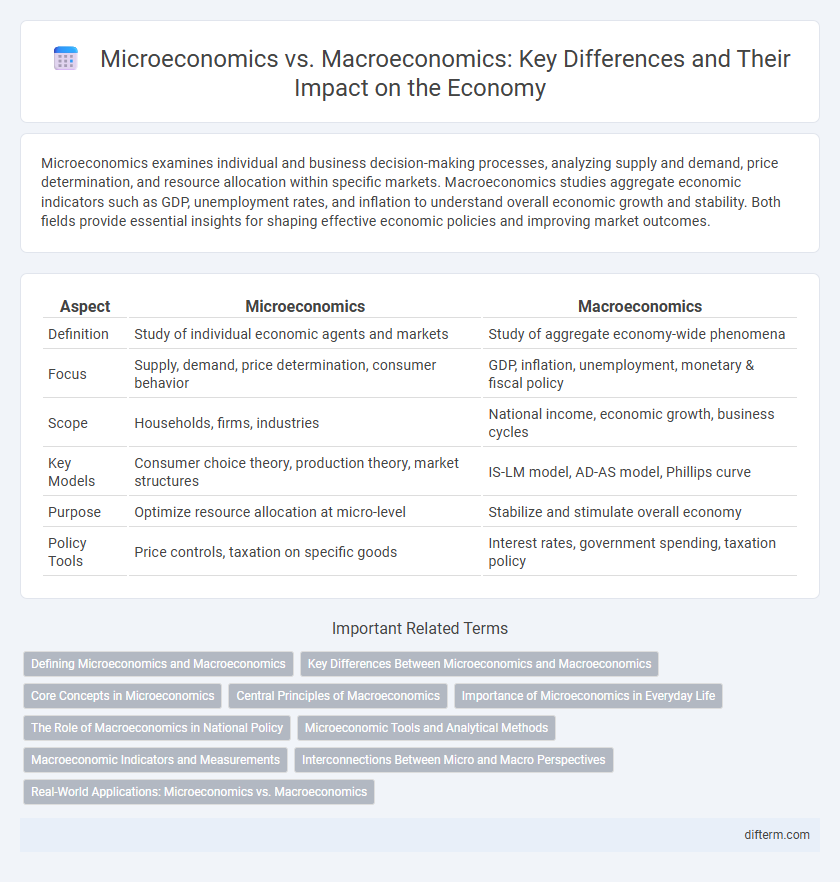Microeconomics examines individual and business decision-making processes, analyzing supply and demand, price determination, and resource allocation within specific markets. Macroeconomics studies aggregate economic indicators such as GDP, unemployment rates, and inflation to understand overall economic growth and stability. Both fields provide essential insights for shaping effective economic policies and improving market outcomes.
Table of Comparison
| Aspect | Microeconomics | Macroeconomics |
|---|---|---|
| Definition | Study of individual economic agents and markets | Study of aggregate economy-wide phenomena |
| Focus | Supply, demand, price determination, consumer behavior | GDP, inflation, unemployment, monetary & fiscal policy |
| Scope | Households, firms, industries | National income, economic growth, business cycles |
| Key Models | Consumer choice theory, production theory, market structures | IS-LM model, AD-AS model, Phillips curve |
| Purpose | Optimize resource allocation at micro-level | Stabilize and stimulate overall economy |
| Policy Tools | Price controls, taxation on specific goods | Interest rates, government spending, taxation policy |
Defining Microeconomics and Macroeconomics
Microeconomics examines individual agents such as households, firms, and markets, analyzing how they make decisions regarding resource allocation, pricing, and consumption. Macroeconomics studies aggregate economic indicators like GDP, inflation, unemployment, and national income to understand overall economic performance and policy impacts. Both branches are essential in forming a comprehensive understanding of economic dynamics at different scales.
Key Differences Between Microeconomics and Macroeconomics
Microeconomics analyzes individual markets, consumer behavior, and firm decision-making to understand price mechanisms and resource allocation. Macroeconomics examines aggregate economic indicators such as GDP, unemployment rates, inflation, and fiscal policy to evaluate national economic performance. The key difference lies in microeconomics focusing on the micro-level economic units, while macroeconomics addresses the overall economy's structure and dynamics.
Core Concepts in Microeconomics
Microeconomics centers on individual markets, consumer behavior, and firm decision-making, emphasizing concepts such as supply and demand, elasticity, and marginal utility. It examines how resource allocation and price mechanisms influence production and consumption at a granular level. Key topics include market structures, consumer choice theory, and the role of incentives in shaping economic outcomes.
Central Principles of Macroeconomics
Macroeconomics centers on aggregate economic indicators such as GDP, inflation rates, and unemployment levels to analyze the overall health and growth of an economy. Key principles include understanding national income determination, fiscal and monetary policy impacts, and the role of government intervention in stabilizing economic fluctuations. These concepts help policymakers design strategies to promote sustainable economic development and control inflation.
Importance of Microeconomics in Everyday Life
Microeconomics analyzes individual decision-making units such as households and firms, influencing daily choices on consumption, production, and pricing. Understanding microeconomic principles helps consumers optimize budgets, businesses set competitive prices, and policymakers design effective regulations to enhance market efficiency. Its emphasis on supply and demand dynamics directly impacts employment, resource allocation, and overall economic well-being at the personal level.
The Role of Macroeconomics in National Policy
Macroeconomics plays a critical role in shaping national policy by analyzing aggregate economic indicators such as GDP growth, unemployment rates, and inflation to guide fiscal and monetary decisions. Policymakers rely on macroeconomic models to design interventions that stabilize the economy, promote sustainable growth, and control inflation. Understanding macroeconomic trends enables governments to implement effective tax policies, public spending programs, and interest rate adjustments that impact the overall economic health of a nation.
Microeconomic Tools and Analytical Methods
Microeconomics employs tools such as demand and supply analysis, elasticity measurement, and consumer choice theory to understand individual market behavior and resource allocation. Analytical methods include marginal analysis, optimization techniques, and game theory to model decision-making by households and firms. These microeconomic tools are essential for examining price determination, market efficiency, and the impact of government policies on individual markets.
Macroeconomic Indicators and Measurements
Macroeconomic indicators such as GDP, unemployment rate, inflation rate, and balance of trade provide critical measurements to evaluate a nation's economic performance and overall health. Real GDP adjusts for inflation to offer a clearer picture of economic growth, while the Consumer Price Index (CPI) measures changes in the inflation rate impacting households. Tracking these macroeconomic metrics helps policymakers implement fiscal and monetary policies aimed at stabilizing the economy and promoting sustainable development.
Interconnections Between Micro and Macro Perspectives
Microeconomics examines individual agents like households and firms, analyzing decisions on resource allocation and pricing, which collectively influence broader economic trends. Macroeconomics studies aggregate indicators such as GDP, inflation, and unemployment, reflecting the combined outcomes of micro-level activities. Understanding the interconnections between micro and macro perspectives is essential for effective policy-making, as individual behaviors shape macroeconomic performance while macroeconomic conditions alter microeconomic incentives.
Real-World Applications: Microeconomics vs. Macroeconomics
Microeconomics analyzes individual markets, consumer behavior, and firm decision-making to optimize resource allocation and price determination in specific industries. Macroeconomics evaluates economy-wide phenomena such as inflation rates, unemployment trends, and GDP growth to guide fiscal and monetary policies for national economic stability. Real-world applications include microeconomic strategies in business pricing models and macroeconomic tools used by governments to manage economic cycles and promote sustainable development.
Microeconomics vs Macroeconomics Infographic

 difterm.com
difterm.com